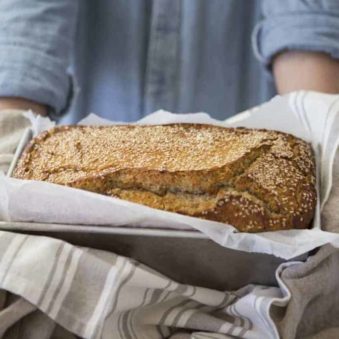Ultimate Guide To Gluten Free Living

A Guide To Gluten Free Living
Over the last few years, gluten-free has received a lot of attention. More people are choosing to adopt a gluten-free diet whether or not they’ve been diagnosed with coeliac disease. You only have to walk down the aisles of the supermarket to notice that gluten-free has become somewhat of a health trend.
More gluten-free foods have entered the marketplace and even foods that don’t naturally contain gluten products have been branded as ‘gluten-free’. Restaurants and cafés are also catering for those who choose to live a gluten-free lifestyle, with many adding ‘GF’ to their menus.
While there are plenty of people adopting a gluten-free diet because they think it’s healthier, there are also a growing number of people identifying numerous health complaints associated with eating gluten. Symptoms include fatigue, gastrointestinal issues, headaches, “brain fog” or aching joints. These people are thought to be suffering from a “non-coeliac gluten sensitivity”.
I personally cut out gluten around 15 years ago, I used to get bloated, fatigued and have terrible stomach pains after eating it. So it was very clear to me that my body didn’t agree with it. I haven’t ever been tested because this was enough real-life data and I always felt better when I avoided it.
I have learned how to be gluten-free without feeling like I am missing out and so this guide to living gluten-free is to share with you what I have learned so you can be informed about what exactly gluten is, why it may cause health problems and how to go gluten-free the healthy way. I’ll touch on what a sensitivity to gluten is and what being coeliac means.
You certainly aren’t alone and missing out on gluten-containing items isn’t the end of the world. It just requires a little savvy and understanding of where it can turn up and the best thing you can do for your health is getting comfortable in the kitchen, so by learning how to make yummy foods yourself you will open up a whole new world of recipes that you can create at home.
What is gluten and why it’s become a problem
Gluten is naturally occurring proteins that are found in the tissue of cereal grains. Gluten contains no nutritional value, but it helps to nourish the plant’s embryos and affects a dough’s elasticity to help with structure. It creates that chewy- texture we love in baked goods and helps the dough hold its shape rather than crumble.
Gluten is naturally found in wheat, barley, rye and triticale (a grain that’s cross between wheat and rye). Oats also contain the gluten protein avenin, but it’s typically more tolerated than the proteins gliadin and glutenin. It’s during the process of oats where cross-contamination with gluten can occur, so it’s technically not gluten-free especially for those who are very sensitive.
The use of gluten began about 10,000 years ago at the introduction of agriculture. Seeds where ground to make flours, which were then used to make cereals and bread.
Our love for gluten-containing products rose rapidly and high-yield wheat varieties were introduced to cater for the demand. Fertiliser, pesticides, and herbicides were used liberally and industrialized farming techniques become the standard. Wheat was bred to stand up to the machinery, transportation, and industrialized food manufacturing methods. It was grown to be a hardier grain and as such, the gluten was stronger than ever. Stone milling was replaced with steel rollers and hammers to cope with the stronger grains. This removed the wheat germ from the grain, which in turn drastically reduced the nutrient content of the flour.
At the same time, the traditional methods of using flours were adjusted to produce more food products. Traditionally, bread was made with a sourdough starter and allowed to ferment over time to activate live cultures. These cultures feed on the starches, sugars, and proteins in the grain, including gluten. These were absorbed slowly and easily digested by our stomach. In fact, the baked goods contained naturally occurring probiotics like other fermented foods such as yogurt, kimchi, and sauerkraut.
The problem with this method was that it took time. Time that food manufacturers and busy housewives didn’t have. So, Baker’s yeast, a powdered form, was commercially produced offering a much shorter fermentation time. Where baked goods needed days to ferment, bread could be churned out in a matter of hours.
So, it’s not gluten itself that’s necessarily the enemy. Modern agricultural methods of creating high-yielding wheat, the use of herbicides and pesticides, industrial baking techniques, and increased use of wheat have all contributed to the drastic rise in the number of people being diagnosed with coeliac disease.
What is a wheat allergy?
A wheat allergy is an overreaction of the body’s immune system to wheat. This can result in skin, gastrointestinal or respiratory disruptions to the allergen. In its most serious form, a wheat allergy can cause anaphylaxis, which if not probably treated can cause death. Other symptoms of a wheat allergy can be skin rash or hives, nausea, stomach cramps, diarrhea, sneezing, running nose, headaches or asthma. Less than 1 percent of people are diagnosed with a wheat allergy, affecting mostly children. As with many childhood allergies, children can grow out of the condition by the age of 12.
A wheat allergy is typically diagnosed by a skin-prick and blood tests or an elimination diet. It’s usually managed by strict avoidance of wheat containing products (both food and non-food) and in severe cases, epinephrine is the first-line treatment.
What is coeliac disease?
Coeliac disease is an abnormal reaction to gluten by the small intestines that results in inflammation. Gluten is perceived as a foreign invader and the immune system responds by attacking the food particles. In the process, the villi, which produce digestive enzymes and absorb nutrients, are damaged. This results in a reduced ability to digest and absorb nutrients causing deficiencies. Coeliac disease is a permanent condition which is usually only resolved through the elimination of gluten-containing products.
Coeliacs also have an increased number of intraepithelial lymphocytes which are cells that line the intestines, protecting food and other foreign particles from entering the bloodstream. This is in response to a perceived threat and results in increased permeability of the intestinal wall or leaky gut. Intestinal permeability can also lead to other sensitivities to foods such as the casein protein found in dairy. This is often why those with gluten intolerances will also have diary intolerances like myself.
The inflammation and damage to the villi causes debilitating and persistent symptoms. Coeliacs can experience gastrointestinal issues such as bloating, stomach pain, flatulence, diarrhoea, constipation and vomiting. They can also suffer from fatigue, joint pains, anxiety, depression weight loss and mouth ulcers.
As coeliac disease can often lead to nutrient deficiencies, further complications can occur such as delayed puberty, amenorrhea, infertility, anaemia and osteoporosis. It’s also common for coeliacs to suffer from autoimmune conditions such as rheumatoid arthritis, thyroiditis, skin conditions and type 1 diabetes.
Coeliac disease is typically diagnosed through a blood test which will confirm the presence of gliadin and anti-transglutaminase antibodies. As the majority of people with coeliac disease contain the coeliac gene, genetic testing can be carried out. This however, doesn’t mean a person with the gene will suffer from any symptoms. A biopsy can also be taken to ascertain whether there is any damage to the villi and an elimination diet is usually carried out.
What is a non-coeliac gluten sensitivity?
As more and more people began suffering from symptoms associated with gluten who were not coeliacs, the term ‘non-coeliac gluten sensitivity’ (NCGS) was born.
People with NCGS don’t have the coeliac gene, the coeliac antibodies or villi damage. However, they do experience inflammation and some damage to the small intestines which the body tends to repair itself once gluten is removed from the diet.
Those with NCGS have an increased number of intraepithelial lymphocytes which are cells that line the intestines, protecting food and other foreign particles from entering the bloodstream.
Although less than coeliacs, NCGS sufferers also have an increased number of intraepithelial lymphocytes, increasing the prevalence of leaky gut and inflammation. The symptoms of NCGS are similar to coeliac disease with most occurring within five or six hours after consuming gluten.
As with coeliac disease, NCGS can lead to the development of other food sensitives and autoimmune conditions. It’s also more prevalent in those who have first-degree relatives with coeliac disease.
There are no specific tests to diagnose NCGS, so usually, an elimination diet is protocol before reintroducing gluten to see if symptoms reappear.
Health conditions linked to gluten sensitives
The increased intestinal permeability, endothelial dysfunction and nutritional deficiencies caused by a gluten sensitivity has been linked with several health conditions. These include:
Autoimmune thyroid disease
Amenrrohea
Addison’s disease
Type 1 diabetes
Rheumatoid arthritis
Lupus
Sarcoidosis
Cardiovascular problems
Anaemia and pernicious anaemia
Lactose intolerance
Gastrointestinal cancers
Lymphoma
Low bone mineral density and osteoporosis
Rickets or osteomalacia
Autoimmune hepatitis
Liver inflammation
Cirrhosis
Multiple sclerosis
Neuropathy
Epilepsy
Depression and anxiety
Behavioural problems in children such as ADHD
Dermatitis
Eczema
Alopecia
Enamel decay
Mouth ulcers
Infertility and recurrent miscarriage
This is by no means a list to scare people, but more about education because a symptom doesn’t neccasarily just have to be digestive like bloated or cramps. Sometimes its joint pain, headaches, weight gain or fatigue and many don’t link that symptom to food.
Are gluten-free products healthier for you?
Today, you’re spoilt for choice when it comes to commercially made gluten-free products. In the supermarket you’ll find breads, pizza bases, pastas, crackers, biscuits and cakes all sporting a gluten-free label. Unfortunately, these products usually aren’t a healthy option.
By removing the gluten, these products need additives to provide elasticity and structure. They’re often highly refined and processed with more calories and less fibre and nutrients. Not to mention, the higher price tag. If you are looking for a gluten-free product, it’s important to look at the ingredients not just the marketing claims.
There are healthy gluten-free products which use naturally gluten-free grains rather than processed substitutes, so best to stick with these. But just because it’s gluten-free it doesn’t mean its better for you.
Signs you may have a gluten sensitivity
Just because you experienced bloating after eating a sandwich or because your child had a tantrum not long after he ate a bowl of spaghetti, it doesn’t mean you have a gluten sensitivity. However, if symptoms like these reoccur, it’s worth becoming aware of when they occur and what the triggers are. It is for this reason, you may like to cut gluten out for 30-60 days to acknowledge how you look, perform and feel and then play around with reintroducing and see if it makes any difference. Also on this note to pay attention to the type of gluten you may reintroduce. I lovely slowly fermented sourdough bread is quite different to a quickly made bread or sugar laden bran muffin.
Here are some common signs you may be sensitive to gluten:
You experience gastrointestinal issues such as bloating, gas, abdominal pain, diarrhoea or constipation.
You feel tired or experience brain fog after eating food containing gluten.
You experience recurrent headaches.
You suffer from anxiety, mood swings or depression.
You have a behavioural problem such as ADHD or ADD.
You become dizzy often.
You have small bumps on the back of your arms.
You experience joint pain, swelling or inflammation.
Your hormones are imbalanced resulting in PMS, PCOS or infertility.
You’ve been diagnosed with an autoimmune disease.
Read the labels
As mentioned previously, not all gluten-free products are healthy due to the additives and additional ingredients such as sugar. When you are steering clear of gluten make sure you read the labels and not only pick up the product just because it says gluten-free. Also, if you have a severe sensitivity, make sure you check the small disclaimer at the back of the product which identifies whether the ingredients may have come in contact with gluten due to cross-contamination. While the ingredients may not contain gluten, some products are made with the same equipment as gluten-containing foods, such as oats.
When eating out
The popularity of going gluten-free has resulted in many restaurants identifying meals free of gluten with the GF symbol. While this is helpful it can also be misleading for those with a severe gluten sensitivity. If this is you, do be sure to ask whether these meals are prepared or cooked in the same area as gluten-containing foods and with the same utensils. If they’re not, this will result in cross-contamination.
Get to know the foods to avoid and to consume
Getting to know what you can and can’t eat will not only prevent symptoms from rising, but also open your eyes up to what foods you can enjoy. You’ll also notice how many foods gluten is in which is half the problem.
Gluten-free foods
Grains & flours: amaranth, arrowroot, buckwheat, cornmeal, rice flour, rice, potato flour, corn flour, flax flour, bean flour, millet, tapioca, teff, sorghum
Eggs
Meat, fish and poultry (not processed, marinated or crumbed)
Vegetables
Nuts and seeds including quinoa
Legumes and beans
Herbs and spices

Gluten-containing foods
Grains & flours: wheat, spelt, kamut, barley, rye, triticale, durum, einkorn, farina, semolina, Graham flour, matzah and couscous
Brewer’s yeast
Wheat starch and malt
Flavoured or crumbed meat, seafood or vegetables
Stuffing
Flavourings or vinegar made of malt
Sauces including soy sauce
Gravy
Oats, unless certified GF
Most bread, cereals, pies, cakes, biscuits, crackers, pasta, noodles, pancakes, tortillas, wraps and pizza
Foods that may contain gluten
Baked goods: bread, cereals, pies, pastries, cakes, biscuits, crackers, and croutons
Pasta and pizza
Energy or muesli bars
Beer
Milkshakes
French fries
Ready-made meals, including frozen
Soups and stocks
Potato chips and corn chips that are flavoured
Processed or imitation meat or seafood
Processed cheese
Sausages and burgers
Lollies, including licorice
Ice-cream and ice-cream cones
Sauces, dressings, marinades and dips
Seasonings and salsas
Flavoured dairy products
Non-food products that may contain gluten
Food additives: starch, hydrolysed vegetable protein, vegetable gum, malt, flavouring
Prescription and some over-the-counter medications
Some vitamins
Cosmetics including lipstick, lip-gloss and balms
Some toothpastes and mouthwashes
Playdough
Should everyone go gluten-free?
Whether or not everyone should go gluten-free is a contentious issue. For many health professionals, modern wheat shouldn’t be consumed due to the way it’s grown, the chemicals used and the modern manufacturing techniques. Many have seen first-hand how removing gluten from a diet can help improve a variety of symptoms and enhance a person’s quality of life.
However, many in the medical and nutrition sector still insist going gluten-free, if you don’t have a gluten sensitivity, is unnecessary and unhealthy. The general argument is that gluten-free products are more expensive and nutritional deficiencies, in particular B vitamins, can occur due to the avoidance of fortified products. Gluten-free products tend to also be low in fibre and other nutrients such as calcium, iron and zinc.
So it’s with this in mind that it’s best to do it the right way and always ensure you are eating a variety of foods. When you eliminate wheat from the diet see what happens, but remember to replace it with naturally gluten-free grains that will continue to provide you with fibre and other essential vitamins and minerals. Avoid the manufactured gluten-free products that sit on the supermarket shelves and consume a balanced diet of whole foods.







